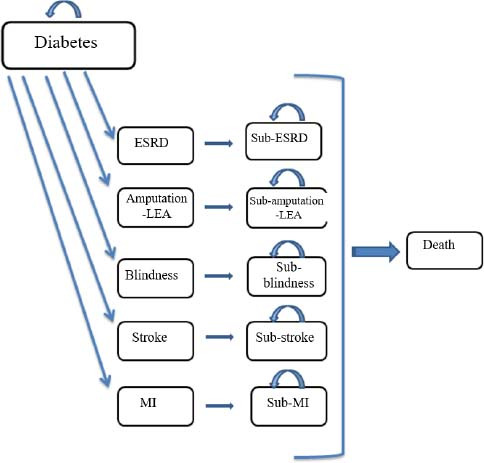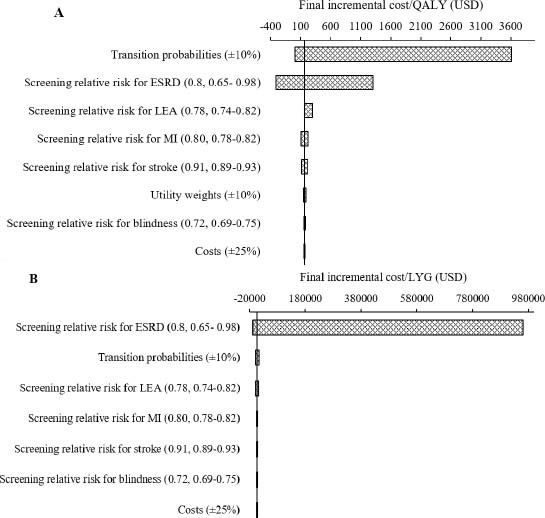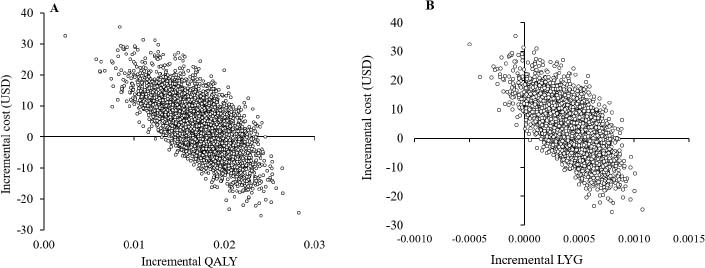伊朗药房2型糖尿病筛查的成本效益和成本效用分析
IF 2.1
Q3 CHEMISTRY, MEDICINAL
引用次数: 1
摘要
背景和目的:几项研究表明筛查项目在降低2型糖尿病及其相关并发症的成本和负效用方面是有效的。由于伊朗人口中2型糖尿病的发病率有所上升,本研究从付款人的角度评估了在伊朗社区药房进行2型糖尿病筛查试验的成本效益。目标人群包括两组,每组1000人,年龄40岁,之前没有糖尿病诊断,干预组(筛查试验)和非筛查组。实验方法:开发了一个马尔可夫模型来评估伊朗社区药房2型糖尿病筛查试验的成本效益和成本效用。该模型考虑了30年的时间范围。干预组考虑了三个间隔5年的筛查方案。评估结果为成本-效用分析的质量调整生命年(QALYs)和成本-效果分析的获得生命年(LYG)。为了检验结果的稳健性,对模型进行了单向和概率敏感性分析。发现/结果:筛选试验的效果更好,成本更高。对于QALYs和LYG,基本情景(无折扣)的增量效应估计分别为0.017和0.0004(大约为0)。增量成本估计为2.87美元/例。估计增量成本效益比为164.77美元/质量aly。结论和意义:本研究表明,在伊朗社区药房筛查2型糖尿病可被认为具有很高的成本效益,因为它符合世卫组织的年人均GDP标准(2020年为2757美元)。本文章由计算机程序翻译,如有差异,请以英文原文为准。



Cost-effectiveness and cost-utility analysis of type-2 diabetes screening in pharmacies in Iran.
Background and purpose: Several studies have shown the effectiveness of screening programs in decreasing the costs and disutility of type-2 diabetes and related complications. As there is a growth in the incidence of type-2 diabetes amongst the Iranian population, the cost-effectiveness of performing type-2 diabetes screening tests in community pharmacies of Iran was evaluated in this study from the payer’s perspective. The target population consisted of two hypothetical cohorts of 1000 people 40 years of age without a prior diagnosis of diabetes, for the intervention (screening test) and no-screening groups. Experimental approach: A Markov model was developed to evaluate the cost-effectiveness and cost-utility of a type-2 diabetes screening test in community pharmacies in Iran. A 30-year time horizon was considered in the model. Three screening programs with 5-year intervals were considered for the intervention group. The evaluated outcomes were quality-adjusted life-years (QALYs) for cost-utility-analysis and life-years-gained (LYG) for cost-effectiveness-analysis. To examine the robustness of the results, one-way and probabilistic-sensitivity analyses were applied to the model. Findings/Results: The screening test represented both more effects and higher costs. The incremental effects in the base-case scenario (no-discounting) were estimated to be 0.017 and 0.0004 (approximately 0) for QALYs and LYG, respectively. The incremental cost was estimated to be 2.87 USD/patient. The estimated incremental-cost-effectiveness ratio was 164.77 USD/QALY. Conclusion and implications: This study indicated that screening for type-2 diabetes in community pharmacies of Iran could be considered highly cost-effective, as it meets the WHO criteria of the annual GDP per capita ($2757 in 2020).
求助全文
通过发布文献求助,成功后即可免费获取论文全文。
去求助
来源期刊

Research in Pharmaceutical Sciences
CHEMISTRY, MEDICINAL-
CiteScore
3.60
自引率
19.00%
发文量
50
审稿时长
34 weeks
期刊介绍:
Research in Pharmaceutical Sciences (RPS) is included in Thomson Reuters ESCI Web of Science (searchable at WoS master journal list), indexed with PubMed and PubMed Central and abstracted in the Elsevier Bibliographic Databases. Databases include Scopus, EMBASE, EMCare, EMBiology and Elsevier BIOBASE. It is also indexed in several specialized databases including Scientific Information Database (SID), Google Scholar, Iran Medex, Magiran, Index Copernicus (IC) and Islamic World Science Citation Center (ISC).
 求助内容:
求助内容: 应助结果提醒方式:
应助结果提醒方式:


